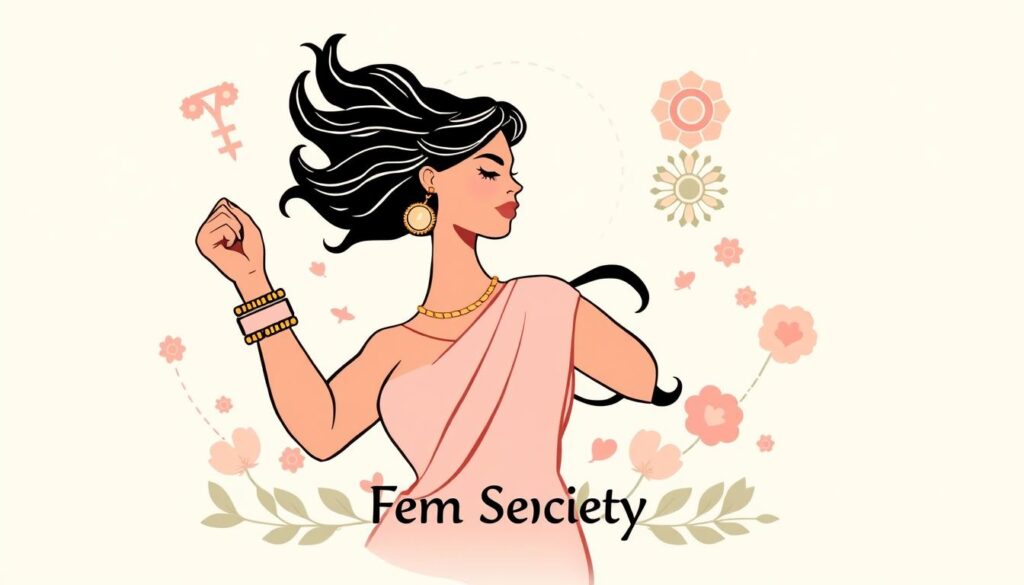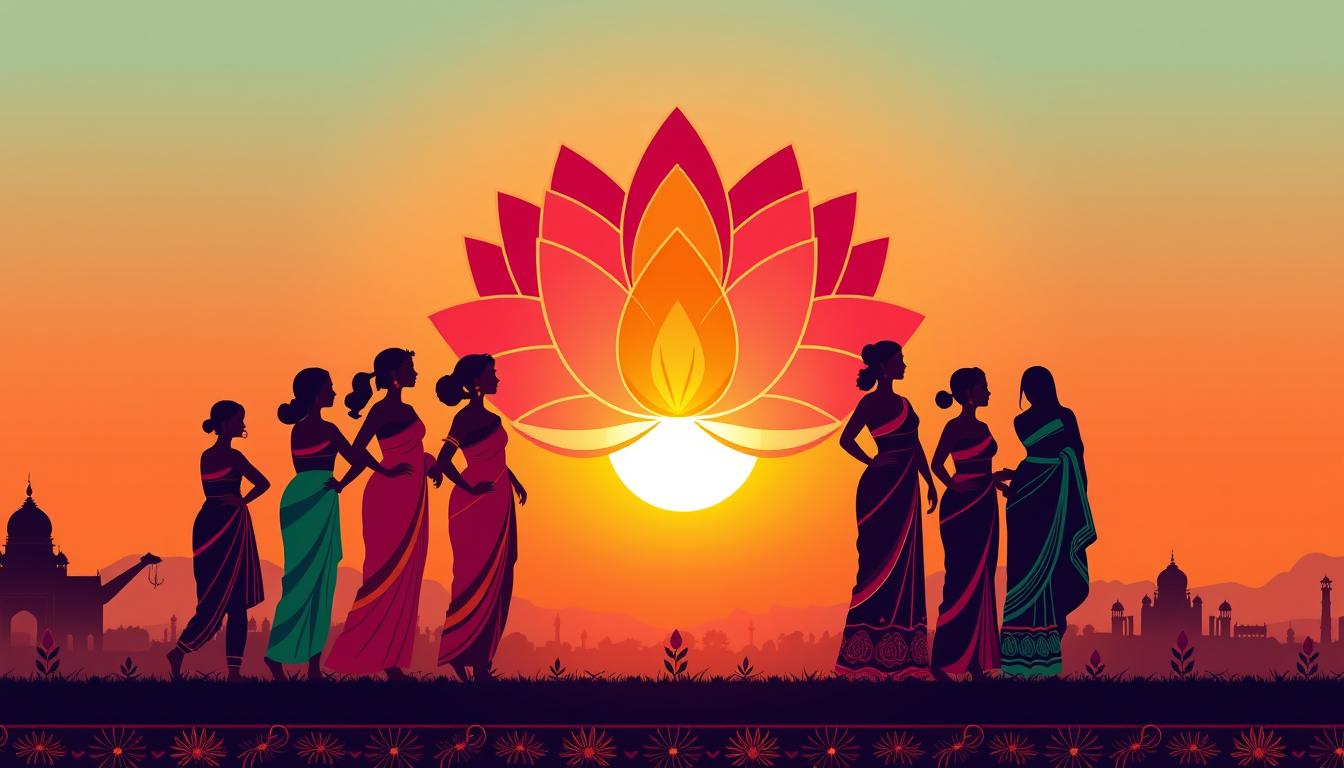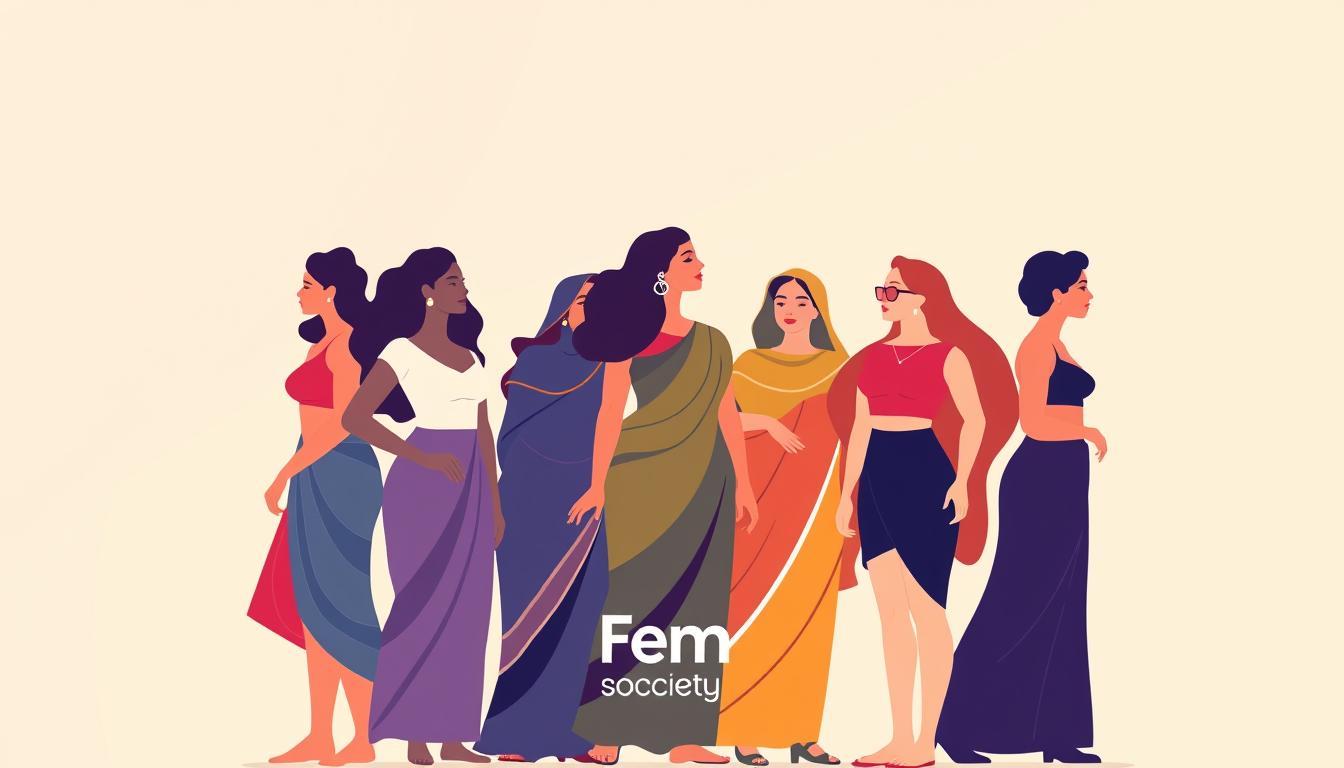Did you know over 80% of Indian women call themselves feminists? They believe in “नारीवाद” (Narivaad) or feminism in Hindi. This shows how important women’s power, or Nari Shakti, is in India. It also shows how many people support the fight for gender equality and change.
Feminism, or “नारीवाद” (Narivaad) in Hindi, is a big movement. It wants equal rights and chances for women everywhere. It fights against unfair treatment of women and wants them to be free and strong.
In India, feminism is all about Nari Shakti. It says women are strong and can do great things. This idea makes women want to stand up for themselves and change their lives and communities.
Key Takeaways:
- Feminism, or “नारीवाद” (Narivaad) in Hindi, is a social and political movement that seeks to achieve gender equality.
- The concept of Nari Shakti (women’s power) is central to Indian feminism, emphasizing the strength and potential of women in society.
- Feminism challenges systemic discrimination and oppression faced by women, advocating for their empowerment, self-determination, and equal rights.
- Over 80% of Indian women identify as feminists, highlighting the widespread acceptance of the feminist movement in the country.
- Understanding the meaning and significance of feminism in the Hindi context is crucial for exploring the diverse facets of the Indian feminist movement.
Understanding the Essence of Nari Shakti in Modern India

“Nari Shakti” means the power of women in India today. It has changed a lot. Women are now seen in many roles, not just old ones.
Feminism has helped change this. It fights for women’s rights and makes sure they are heard.
Historical Evolution of Women’s Empowerment
The women’s movement in India started a long time ago. The All India Women’s Conference (AIWC) was formed in 1926. This was a big step for women’s rights.
Since 1947, India has worked to help women. They focus on health, education, and jobs. This shows India’s effort to fix gender issues.
Role of Feminism in Shaping Indian Society
Feminism in India grew strong in the 1970s. It pushed for equal rights for women. The movement tackled many issues, like unfair laws and child marriage.
It also fought against caste and social biases. This shows feminism’s wide reach in India.
Cultural Context of Nari Shakti
Nari Shakti is deeply connected to Indian culture. Hinduism has played a big role in this. It has many goddesses and teachings that support women’s empowerment.
The government is also working to help women. They use Ayurveda and Yoga. They also want to improve women’s education.
Recently, the government has done a lot for women. They started the ‘Nari Shakti’ campaign in 2015. Women are now in more roles. They celebrate Nari Shakti on Republic Day too.
Feminism Meaning in Hindi: A Comprehensive Guide

Feminism in Hindi is called नारीवाद (Narivaad). It’s about making sure men and women are treated equally. It fights for women’s rights in many areas.
The feminism meaning in hindi wikipedia says it’s about equal rights for both sexes. Feminism meaning in hindi and examples show how women fought for the right to vote and work. The feminism meaning in hindi pdf and feminism meaning in hindi oxford explain the ideas behind feminism.
In India, feminism has a long history. It started in the 19th century. Many women, like Savitribai Phule, have fought for women’s rights. Today, women like Kavita Krishnan keep pushing for equality.
| Book Title | Price (USD) | Pages | Publisher | Format | Dimensions | Weight |
|---|---|---|---|---|---|---|
| “Feminism Meaning in Hindi – Understand Nari Shakti” | $17.25 | 291 | Orient Blackswan Pvt. Ltd. | Paperback | 8.50 X 5.50 inches | 270 grams |
The Indian feminist movement is connected to global efforts. Feminism meaning in hindi wikipedia shows how women’s rights are linked worldwide. Knowing about feminism meaning in hindi and examples helps us understand the movement better.
“Feminism is the radical notion that women are human beings.” – Cheris Kramarae
This guide helps you learn about feminism in India. It covers the movement’s history, ideas, and impact. Whether you’re reading the feminism meaning in hindi pdf or exploring the feminism meaning in hindi oxford, you’ll gain a deeper understanding.
Core Principles of Indian Feminist Movement

The Indian feminist movement fights for social equality, political rights, and economic empowerment of women. It aims to give everyone the same chances in education, work, and life. The movement tackles many issues like reproductive rights, domestic violence, and equal pay.
Social Equality and Justice
Feminists in India lead the fight for social equality and justice. They challenge old ways that hurt women and push for change. They work to stop violence, ensure education, and get women into leadership roles.
Political Rights and Representation
The movement also pushes for political rights and more women in power. They want laws that let women have a say in politics. They also work to remove obstacles that keep women out of politics.
Economic Empowerment
Economic empowerment is key for the Indian feminist movement. They fight for equal pay, financial freedom, and career chances. They aim to close the pay gap, support women in business, and ensure women have the same job opportunities as men.
| Focus Area | Key Achievements |
|---|---|
| Social Equality and Justice |
|
| Political Rights and Representation |
|
| Economic Empowerment |
|
The Indian feminist movement has changed society, politics, and economy for women. It focuses on key areas to empower women and fight for equality. This movement keeps shaping women’s rights and chances in India.
“Feminism is the radical notion that women are human beings.” – Cheris Kramarae
Different Schools of Feminist Thought in India

The feminist movement in India has many views. Each one tries to solve gender inequality and help women. From liberal feminism to radical feminism, the ideas have grown a lot. They show the complex social, cultural, and political life of India.
Liberal feminism in India wants equal rights and chances for women. It works on legal changes, education, and fair work places. It says women should be part of main society and not face many barriers.
Radical feminism fights against the old ways that keep women down. Radical thinkers in India work hard to change old gender roles and norms. They want to free women from being treated unfairly.
Eco-feminism is a new idea in India. It links feminism with the environment. Eco-feminists say women, especially in poor areas, suffer more from nature’s harm. They want a green and fair world.
Black feminism is a global movement that is growing in India. It talks about the special problems women of color face. Indian scholars and activists add to this talk. They share the stories and views of women who are often ignored.
These different views make the Indian feminist movement strong. They help us see and tackle gender-based problems in many ways. This mix of ideas makes the feminist talk in India rich and powerful. It helps women and brings about change.
“Feminism is the radical notion that women are human beings.” – Cheris Kramarae
Liberal Feminism and Its Impact on Indian Society

The liberal feminist movement in India has made big steps. It fights for gender equality through laws, education, and work equality. It believes women should have the same rights as men. This has changed India’s society and politics a lot.
Legislative Reforms
Liberal feminists in India have pushed for legal changes. They want to end gender-based discrimination and empower women. Laws like the Equal Pay Act and the amended Civil Rights Act help ensure fairness at work. These laws are key to fighting against old ways and helping women be financially independent.
Educational Initiatives
Education is a big deal for liberal feminists in India. They see it as a way to empower women and change society. They’ve worked to get more women into education, especially in fields where men are usually found. This has helped close the education gap and opened doors for women in different careers.
Workplace Equality
The liberal feminist movement has also worked hard for equality at work. They fight against pay gaps, job segregation, and discrimination. They push for equal pay, end job segregation, and improve work conditions. This helps women be more independent and have a fair chance in the workplace.
Even though liberal feminism has helped a lot, some say it doesn’t solve all problems. But, its impact is still felt in the fight for women’s rights and empowerment in India.
Radical Feminism: Challenging Patriarchal Structures

Radical feminism in India is a strong movement. It fights against the old ways of society. It wants to change everything to make sure everyone is equal.
Radical feminists in India work hard on many issues. They fight against violence, help with women’s health, and change old gender roles.
Radical feminism believes that men have too much power. They say we need to change the whole system, not just a little bit.
“The root cause of women’s oppression, according to radical feminists, lies in patriarchal gender relations.”
Radical feminism talks about changing how we see sex and bodies. They want women to be free from control by others. They also want women to have choices about their bodies and sex.
Radical feminists in India lead fights against many issues. They tackle domestic violence, rape, and more. They want to make society see these as wrong and change it.
Not everyone agrees with radical feminism in India. Some think it’s too radical. But, it’s a strong voice for change and equality.
Intersection of Feminism with Indian Culture

The Indian feminist movement meets a rich mix of cultural, religious, and social customs. This mix often leads to lively debates. These debates are about women’s roles in religious practices, social norms, and cultural traditions.
Traditional Values vs. Modern Perspectives
The idea of cultural feminism meaning in hindi shows the tension between old customs and new views on gender equality. The concept of intersectionality meaning in hindi feminism is important. It helps activists understand how caste, religion, and class affect Indian women’s lives.
The feminism at its peak meaning in hindi has made us see that feminism isn’t the same everywhere. The Indian way of life, shaped by history and culture, is different. This makes us question what it means to be a woman in India.
Religious and Social Customs
Debates about women’s roles in religion and society show the complex mix of feminism and Indian culture. The Indian way of life makes it hard to apply universal feminist ideas. The country’s many religions and social structures affect how we see gender equality.
Issues like women’s seats in Parliament show the complex mix of gender, caste, and class. These issues come up in the big changes brought by democracy in India.
“The instability of the category ‘woman’ in Indian feminism is attributed to the disruptive impact of issues surrounding caste, religious community identity, and sexuality, which challenge traditional notions of gender identity and female experience.”
Contemporary Challenges in Indian Feminism

The modern feminist movement in India is growing but faces many challenges. One big issue is intersectionality. This means women’s lives are shaped by gender, class, caste, religion, and ethnicity. Feminists must make sure the movement includes all Indian women, not just the ones in cities and schools.
Gender-based violence is a huge problem in India. There are many rapes and acid attacks. Also, more false rape cases are happening. Women’s safety is a top concern. Feminists need to push for better laws and enforcement to stop this violence.
Women’s economic power is also important. Rural women help a lot with farming but don’t own land. Fewer women are working in jobs, showing the need for more jobs and economic freedom.
Indian feminism is also seen as elitist. It seems out of touch with poor and marginalized communities. Feminists must work to include all women, no matter their wealth or status.
“Feminism is not about making women strong. Women are already strong. It’s about changing the way the world perceives that strength.” – G.D. Anderson
To overcome these challenges, we need many strategies. We need laws, activism, and understanding women’s lives in India. By tackling these issues, Indian feminism can make real changes and empower women everywhere.
Role of Social Media in Modern Feminist Movement

Social media is a big help for feminism in India. It helps spread ideas, builds online groups, and supports local actions. But, it also has problems like online bullying and false news.
Digital Activism
The feminist movement in India has changed a lot with digital activism. Online, we can talk about women’s rights, share info, and get people to fight for equality. Feminism urge meaning in hindi and feminist discourse meaning in hindi are now easier to find online.
Cyberfeminism is a new way to fight for feminism. It makes old ways of activism better by helping many people join fast. Things like the ‘Everyday Sexism Project’ and the ‘#FeministsAreUgly’ hashtag on Twitter are making a big difference.
Online Communities
Online, feminist groups have formed where people can share and plan together. Blogs and petitions let feminist spotted meaning in hindi speak up and ask for change.
The ‘Me Too’ movement against sexual harassment became famous on Twitter. The ‘When Women Refuse’ blog shared stories of sexual violence. These online places help quiet voices be heard and bring people together.
“Social media has changed the world by making feminism more open and powerful through social media and blogging.”
But, digital activism has its own problems. Not everyone has internet, which can make feminism seem exclusive. Also, false news and online bullying are dangers to feminism’s progress.
Even with these issues, social media is very important for feminism today in India. Young feminists on social media are helping to make the movement stronger and more aware of gender equality. Sites like TikTok, Instagram, and Twitter help share feminist stories and work towards a fairer world.
Legal Framework Supporting Women’s Rights in India

India has made big steps in protecting women’s rights. It has laws and policies for domestic violence, sexual harassment, and gender bias. These laws help women in the workplace and society.
India joined the Convention on the Elimination of All Forms of Discrimination against Women (CEDAW) in 1993. This treaty is signed by about 189 countries. It makes India promise to stop discriminating against women.
The National Human Rights Commission (NHRC) of India helps with CEDAW and other rights treaties. It studies these treaties and gives advice on how to follow them in India.
India also has its own laws for women’s rights. These include the Domestic Violence Act, the Sexual Harassment of Women at Workplace (Prevention, Prohibition and Redressal) Act, and the Equal Remuneration Act. These laws protect women.
But, there are still problems in making these laws work. The feminist movement in India and feminist jurisprudence help fix these issues. They make sure women’s rights are part of India’s laws and policies.
There are programs to help women in India. These focus on education, health, money, and skills. The Indian government also works with countries like the UK to help women’s rights.
“The true measure of any society can be found in how it treats its most vulnerable members.”
As India grows, the feminist movement and laws for women’s rights are key. They help make India fairer and more welcoming for everyone.
Future of Feminism in Indian Context

The future of feminism in India looks bright. It will face new challenges and adapt to changing social norms. The strategic feminist meaning in hindi and post feminism meaning in hindi will grow. This will help India’s feminism tackle big issues and bring about real change.
Intersectionality will be key in the future of Indian feminism. It’s about seeing how gender, class, caste, and more connect. This will make feminism more inclusive and fair for all women.
The digital world brings both good and bad for feminism in India. Social media and online activism spread ideas fast. But, dealing with online bullying and fake news is important for feminism’s future.
Indian feminism’s success depends on its ability to change with society. It must keep fighting for gender equality, tackle intersectional issues, and use technology wisely. This will help create a fairer world for everyone.
“Feminism is not about making women stronger. Women are already strong. It’s about changing the way the world perceives that strength.”
As India moves ahead, the strategic feminist meaning in hindi, post feminism meaning in hindi, and waves of feminism meaning in hindi will shape gender equality. They will empower the next generation and build a more inclusive future.
Empowering Next Generation Through Feminist Education

Feminist education is key to empowering the next generation. It mixes feminist epistemology meaning in hindi, feminist ethics meaning in hindi, and feminist theory meaning in hindi into school lessons. It also uses gender-sensitive teaching and teaches about gender issues.
This education aims to challenge old power structures and push for gender equality. It teaches students to think critically and question unfair gender norms.
Through workshops and discussions, students learn to be change-makers. They get to know feminist epistemology, feminist ethics, and feminist theory. This prepares them to fight for gender justice.
Feminist education also talks about intersectionality. It shows how gender, race, class, and sexuality all matter. This helps students see the world from different angles.
This education builds critical thinking, empathy, and teamwork. It prepares students to lead in a fairer world. They will fight for women’s rights and work for equality.
“Feminist education is not just about teaching women’s history or adding women’s perspectives to the curriculum. It’s about fundamentally transforming the way we think, learn, and engage with the world around us.”
Teaching the next generation through feminist education is a big step towards equality. It teaches them about feminist epistemology meaning in hindi, feminist ethics meaning in hindi, and feminist theory meaning in hindi. This way, we can inspire and prepare the leaders of tomorrow for a fairer world.
Conclusion
The Indian feminist movement is growing strong. It fights for a fair society. It mixes old traditions with new ideas for equality.
This movement helps women in many ways. It makes them strong in society, politics, and work. It also listens to many different views.
Big changes have happened because of this movement. Laws have changed, schools have improved, and work places are fairer. But, there’s still more to do.
Women from all walks of life need to be heard. The movement must keep fighting against old ways. It must also speak up for those who are left behind.
The movement will face new challenges ahead. It will need to help transgender people and work with other groups. But, it will keep going because of its deep roots and strong belief in equality.
FAQ
What is the meaning of feminism in Hindi?
Feminism, or नारीवाद (Narivaad) in Hindi, is a movement for gender equality. It fights against women’s discrimination. It wants women to have the same rights and chances in all areas of life.
What is the concept of Nari Shakti (women’s power) in Indian feminism?
Nari Shakti means women’s power in Indian feminism. It shows women’s strength and potential in society. It has grown from old roles to modern empowerment, affecting many areas of life.
What are the different schools of feminist thought in India?
Indian feminism has many schools, like liberal, radical, Marxist, and eco-feminism. Each has its own way to fight gender inequality and empower women in India. This makes the feminist discussion rich and complex.
How has liberal feminism impacted Indian society?
Liberal feminism in India works for gender equality through laws and education. It has led to big changes in laws and education. But, some say it doesn’t solve all the deep problems in India.
What are the core principles of the Indian feminist movement?
The Indian feminist movement wants social equality, political rights, and economic power for women. It fights for equal education, jobs, and personal rights. It also tackles issues like reproductive rights and violence against women.
How does feminism in India intersect with cultural and religious customs?
Feminism in India meets with cultural and religious traditions. It debates women’s roles in these areas. This leads to discussions on gender equality and tradition.
What are the contemporary challenges faced by Indian feminism?
Today, Indian feminism faces challenges like dealing with violence and economic issues. It also faces criticism for being elitist. It needs to include more voices.
How has social media impacted the feminist movement in India?
Social media has helped Indian feminism a lot. It spreads feminist ideas and supports movements. But, it also has problems like online harassment and false information.
What is the role of feminist education in empowering the next generation in India?
Feminist education is key for empowering the next generation. It adds feminist views to learning. It teaches gender awareness and fights for equality among young people.
